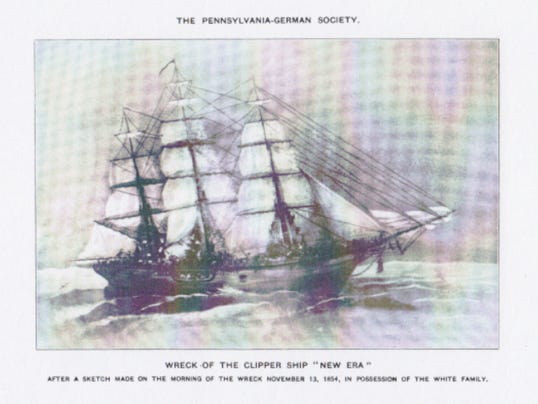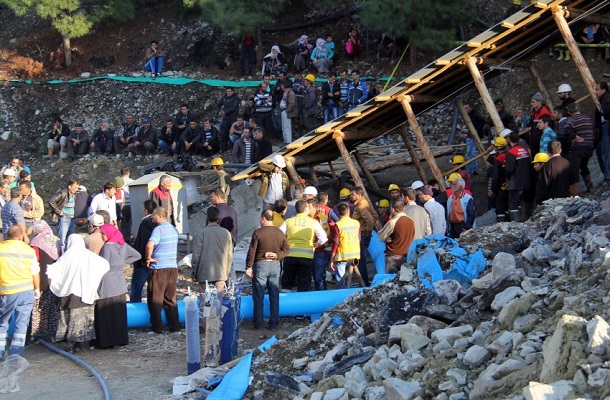
Most Jersey Shore residents know the story of the SS Morro Castle, the doomed ocean liner whose smoking hulk burned off an Asbury Park beach in 1934.
But far fewer know the story of a much deadlier shipwreck, which happened 80 years before, in almost the exact same spot where the Morro Castle ran aground — a disaster so profound that it helped lead to the expansion of the United States Lifesaving Service, which eventually morphed into the U.S. Coast Guard.
The clipper ship New Era was carrying nearly 400 men, women and children — mostly German emigrants — when it struck a sandbar during a nor’easter off a desolate section of what was then called Deal Beach on Nov. 13, 1854. Last week marked the 160th anniversary of the tragedy.
So high were the ocean swells and so ineffective was the life-saving equipment at the time that 240 people were lost in the disaster, which happened very close to where Convention Hall now stands. Nearly 200 were trapped on the ship overnight, and many died of exposure as wind-whipped waves washed over them and crew members abandoned ship, leaving the passengers alone.
Frustrated rescuers, stymied by heavy swells that prevented rescue boats from reaching the sinking ship, built bonfires on the beach to let the survivors know they were still there.
“One author refers to it as a perfect wreck,” said Dr. Richard G. Fernicola, an Allenhurst resident and local historian who has studied the New Era tragedy. “The ship was more or less totaled, and unsalvageable.”
The hull of the sailing ship lies buried beneath at least 15 feet of sand off Seventh Avenue, Fernicola and other researchers believe. So far, attempts to find it have proven fruitless, although some artifacts from the New Era have been recovered.
The ship’s massive anchor, discovered in 1999, now sits at the corner of Elberon and Norwood avenues in Allenhurst, along with a plaque memorializing the victims. And a large wooden section of what is believed to be the New Era recently was found off the Eighth Avenue jetty in Asbury Park.
Those are all the artifacts that remain from a ship that Fernicola said seemed star-crossed almost from the start of its journey in 1854.
An economic downturn in the German states and civil unrest following the revolutions that happened in parts of Europe in 1848 led more than 1 million Germans to leave for America between 1845 and 1855. Emigrant recruiters would travel from town to town, trying to convince people to leave for America.
The New Era sailed from Bremen on Sept. 28, 1854, heading for New York. Even in the best of times, it was not an easy crossing. Passage to the U.S. in the 1850s took an average of 43 days, according to the Smithsonian National Museum of American History. Most passengers traveled in steerage, below decks, and lived in damp, unsanitary conditions. Rats, insects and disease were common.
In the case of the New Era, the disease was cholera, an infection of the small intestine that’s typically transmitted through contaminated food and water. One person died in Bremen before the ship had even left port, Fernicola said. Another 39 died of the disease during the crossing.
Rough seas dogged the ship, according to Capt. Thomas J. Henry. Henry, whose statement was included in a history of the New Era that was published in 1907 by the Pennsylvania German Society, said on Oct. 20, huge waves swept everything from the deck, killing “two or three” passengers and injuring several others.
The ship began leaking, and passengers were called on to help pump water, the captain said. By the time the New Era grounded on the sandbar, it had been at sea for 46 days.
The Jersey Shore area near where the New Era ran aground was a rural, almost desolate place in 1854, the beaches covered with sand dunes and scrub pines. Asbury Park did not yet exist, and the area was sparsely populated by farmers and fishermen. Farmer Abner Allen, whose farm makes up most of what is today Allenhurst, was the only local resident who occasionally would take in summer visitors.
The waters off the Jersey Shore were known to be treacherous. There are thought to be as many as 7,200 shipwrecks off New Jersey’s coast, some dating from colonial times, according to Dan Lieb of the New Jersey Historical Divers Association.
Margaret Thomas Buchholz called the Jersey Shore the “Graveyard of the Atlantic” in her 2004 book, “Shipwrecks of the Jersey Shore.” Vicious nor’easters, roiling fog and shifting sandbars are among the natural hazards that have made the Jersey coast one of the most difficult to navigate in the world.
Rescuers respond
Allen was also the volunteer keeper of the local lifesaving station, located north of Deal Lake in what is now Loch Arbour. Hearing the ship’s bells and the firing of its distress rocket, along with the screams of hundreds of passengers, Allen was on the beach within minutes, Fernicola said.
It was around 6 a.m. on Nov. 13. Through the mist and rain, Allen could see that the New Era had run aground at least 300 yards from shore. A driving wind turned the ship around, as waves broke over the vessel. The New Era sank rapidly, and panicked passengers clung to the ship’s rigging in an attempt to keep from being washed overboard.
The news of the wreck spread quickly and men came from Long Branch, Freehold, Red Bank and near what is now Manasquan to attempt a rescue. Unfortunately the seas were too high for them to reach the boat, so they used a life-car, a buoyant metal, pod-shaped vehicle that could securely carry people from a shipwreck to shore.
Allen and other men on shore used a cannon-life gun to shoot sturdy lines in the direction of the New Era. If the lines could reach the ship they would have been tied to the mast, allowing passengers to enter the life-car and be pulled to shore by those on land.
But repeated attempts to fire the lines to the ship failed; they either missed, or the lines broke. About noon, a line did make it to ship, and a lifeboat was launched from the ship, to be pulled ashore by the rescuers. The captain jumped into the boat along with part of the remaining crew. When 10 or 12 passengers jumped in after them, most were beaten back by the crew. All but four of them drowned.
Having run out of powder to fire the small cannon, the men on the beach had to send for more in Avon. Meanwhile, a portion of the ship had collapsed, sweeping 80 to 100 people into the cold, wild sea.
Rescuers thwarted
A lifeboat was lowered by crew members who were supposed to help bring a rescue line from the New Era to shore. Instead, they cast off the line, abandoned the ship and rowed toward shore. Other crew members lowered another boat and cut the line so no passengers could get on board.
By now, it was almost dark. Unable to reach the remaining 170 New Era passengers, the frustrated men on the beach lit bonfires to encourage the people on the ship. The night was cold, with a westerly wind, and the waves pounded against the ship as the passengers clung desperately to any bit of rigging they could find.
Before daybreak, the seas began to calm a bit and the rescuers at last reached the New Era with their surf boats. As waves broke over the deck of the ship, which was now almost level with the sand, the local men worked tirelessly to rescue those who were still alive.
Only 135 passengers — almost all men — were found alive. Within 2½ hours, all of them had been rescued and brought ashore. Those who helped rescue people from the wreck of the New Era were appalled at what they saw.
“Multiple writers at the time of the New Era used almost the same one-line statement when writing about the shipwreck, basically stating that never before in the experience of the writers had they ever seen, or ever hoped to see again, the gruesome sight they beheld when they boarded the New Era,” Fernicola said. The passengers had been on the deck, exposed to the elements, for more than 24 hours.
Author Stephen Crane, who later lived in Asbury Park, would mention the passengers of the New Era in a ghost story.
Abner Allen and his wife helped care for many of the survivors, while the bodies of the dead were taken to Allen’s boarding house. “If they didn’t live close by and were not of that character, who knows what would have happened,” Fernicola said of the Allens.
Not all at the Shore were as charitable as Allen. For years, stories persisted of residents taking jewelry, coins and clothing from the bodies of the dead.
Most of the bodies could not be identified. They were buried in a mass grave at the Old First United Methodist Church cemetery in what is now West Long Branch. A marker was erected over the gravesite in 1892.
The next year, the founder of Asbury Park, James Bradley, erected a 12-foot-high granite monument to the New Era shipwreck on the boardwalk, probably at Seventh Avenue. But the monument, like the New Era, was ill-fated. The next year, a powerful storm knocked the granite obelisk off its boardwalk perch and buried it in the sand.
It has never been found, in spite of the Asbury Park Historical Society’s efforts to find it in 2012, using ground-penetrating radar.
The wreck of the New Era, along with that of the Powhattan, another emigrant ship that ran aground off Beach Haven earlier in 1854, killing everyone aboard, helped pave the way for a paid lifesaving service along the coast.
“There was a formalized effort to get a permanent crew and facilities to house the man and the equipment,” Fernicola said.
Saturday 15 November 2014
http://www.app.com/story/news/history/2014/11/14/shipwreck-asbury-park-helped-create-coast-guard/19045359/





























